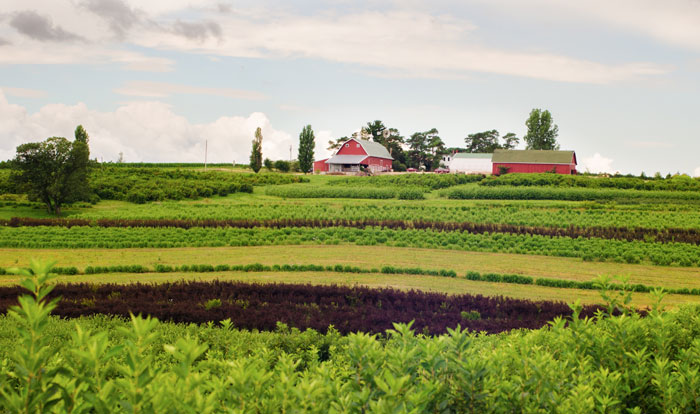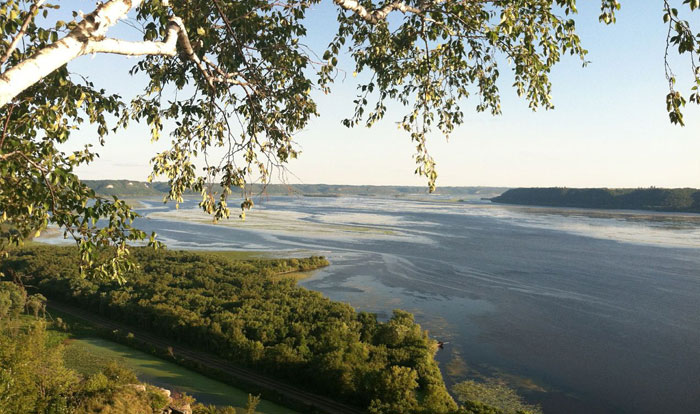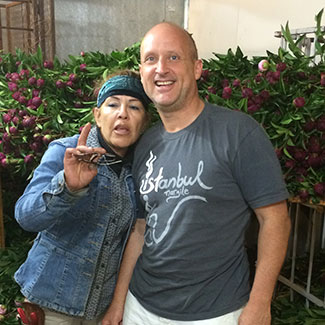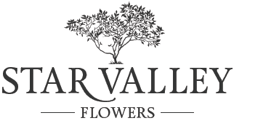OUR STORY
Two hours southwest of Madison, Wisconsin, tucked away in the hills of the Driftless Region, is our cut flower operation that grows anything but the ordinary. We’ve found our niche by growing specialty cut flowers, primarily woody ornamentals and perennials, with a year-round offering to the floral, landscape, and events trades.

Our business is headquartered on this homestead farm in southwestern Wisconsin, just a few miles from the Mississippi River.
Today, with 165 acres in production and with Chicago as our primary transportation hub, we ship our products as far west as Honolulu and as far east as Boston. We are the largest entirely field-grown cut flower producer in the Midwest – with no greenhouses, minimized fossil fuel use, and stringent soil conservation practices for our hilly terrain. Our customer base includes floral wholesalers, retail grocers, garden centers, floral designers, landscapers, and event planners.
Not an easy start
We started out small on two acres in 1986. Owner, John Zehrer, had always had a love for horticulture. Even as a child he sold plants he, himself, had propagated. The son of a farmer, John first dabbled in bee-keeping and dairy farming in California and Wisconsin before realizing that profits in these endeavors were difficult to achieve.

Our original flower farm was up on the ridge above the tiny hamlet of Star Valley, Wisconsin.
With the goal of pursuing a horticulture degree, he sought admission to the University of Minnesota, but was denied enrollment. Not to be easily discouraged, John contacted Horticulture Department head Dr. Harold Wilkins, who was very encouraging and provided John with the information he needed to start a flower business on a dairy farm he had previously operated. Star Valley Flowers began, like many other cut flower farms, by producing annuals and perennials. These were sold to wholesalers in Minneapolis. The early years were not easy, with John facing numerous obstacles such as drought, irrigation problems and marketing disadvantages caused by his relative inexperience in the floral trade. But persistence and advice from friends and business contacts helped him to overcome these hurdles.
In 1997, John purchased the current farm. It was originally homesteaded in the 1850’s by a man named Mr. Knutson. To keep his son at home and helping him with the farm, he placed an ad offering to give the farm to anyone who would take his son’s place in the Union Army and go fight in the Civil War. If they came back alive he’d give the farm to them. The grandfather of Clifford and Chris Anderson accepted his challenge and took possession of the farm when he returned from the war. John Zehrer bought the farm from his elderly grandsons Clifford and Chris in 1997 – this transaction marked the first time money had ever been exchanged for the property. The original barn was hit by lightening and burned to the ground in the 1920’s. Today, there are numerous lightening rods on every building on the property!
Crop selection and business expand
The early crops, including sunflowers, zinnias, ageratum and amaranthus, which were sold at farmers’ markets, provided John with a base income that enabled him to branch out and try more unusual plants. He added willow varieties, hydrangeas, lilacs, bittersweet, peonies and more. Star Valley Flowers quickly gained a reputation as a source for hard-to-find and novelty items.

Our managed permaculture approach to farming protects our soil, even in hilly terrain.
Today, well over 150 acres of the farm are planted with deciduous shrubs such as spirea, lilacs, hydrangeas, snowball and cranberry viburnums, numerous willows, twig dogwood, Ilex verticillata, mock orange, ninebark, forsythia. We are a major supplier to the Chicago and Minneapolis markets, where wholesalers and forward-thinking retailers, such as Whole Foods Market, supply their customers with our regionally-grown products. Chicago’s O’Hare Airport connects us to the entire nation, as well.
Production considerations
We choose items that are easy to grow and thrive in the unique environment of the Driftless Region, because if a crop doesn’t grow well here, somebody else will grow it better somewhere else. Hardiness in USDA zone 4 is mandatory. Tried and true Midwestern perennials used in landscapes are the backbone of our business. Numerous Lilac varieties, Spirea and Mock Orange are choice spring bloomers that can weather most anything Mother Nature dishes out.
The harvest “window” is another major consideration in our choice of crops. Cranberry viburnum, hydrangea and bittersweet are examples of crops that can be harvested when the market demands, instead of having a distinct time when the crop is ready and all the product comes to the market at once. Weather is the last major consideration with drought and or flooding have also had a great impact over the years as we do not have irrigation available to all crops.

By growing woody branches with attractive bark such dogwood or berries such as Ilex, bittersweet, and crab apple, we are able to extend our growing season into fall and winter, which also allows us to keep more employees year round.
Our backyard – the Driftless Region

The Mississippi River winds through the Driftless Region
Our area in Wisconsin’s beautiful Driftless Region is home to many of the farms that provide Minneapolis and Chicago with organic and sustainably grown foods. In fact, Wisconsin is second only to California in its total number of organic farms. Family-owned farms, like ours, are a major factor in our rural economy, providing jobs and income to our local communities. Along with a renewed food culture, our region attracts outdoor recreation enthusiasts, ecologists, writers, musicians and artists of all kinds. We highly recommend our area as a weekend get-away destination for our Chicago and Minneapolis friends. With enough advance notice, we can plan a farm tour for you, as well. Learn more about visiting at www.driftlesswisconsin.com and enjoy the recent documentary Mysteries of the Driftless.
Great minds and great people
John is not the only great mind behind Star Valley Flowers. Back in the late 1990’s, John convinced longtime friend Phil Mueller to move from Puget Sound in the Northwest to join him again on the farm. Phil had previously sold flowers for Star Valley during the first two years it was in business. Carlos Tinoco joined the team not long after in field production and is the head of production for the farm today.


Left: John Zehrer, owner and horticulturist, pictured with his wife, Berta. Right: Phil Mueller director of sales and marketing since 1999, pictured with Belén Vesbach.
In 2022, Tim Clesen purchased the Soldier’s Grove farm. Tim is also Part owner of Clesen Wholesale. Clesen Wholesale has been the biggest supporter of Star Valley for a number of years. John still owns the Beloit Farm with Star Valley as its sales outlet. Tim brought on Billy Cioffi who he worked with for over a decade at Clesen Wholesale. Billy was previously a corporate buyer for Mayesh Wholesale for a decade leading up to his return to the Midwest.
We couldn’t do it without the dedicated employees who help with everything from planting and harvesting to packing, shipping, and bookkeeping. Many of our staff have been with us for more than twenty years, and their hard work allows us to continue growing and developing new crops. We are also grateful for our industry friends and organizations such as Association of Specialty Cut Flower Growers. John has been an active member for many years and has served as director of the association’s Midwest regional chapter. The association and its annual conference is a great forum for meeting other growers and buyers, learning new techniques, sharing information and getting questions answered.
Special thanks to these talented photographers for allowing us to show their images on this website: Mandy Kellogg, Jerry Quebe, Julio Cano
